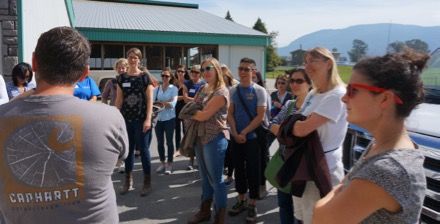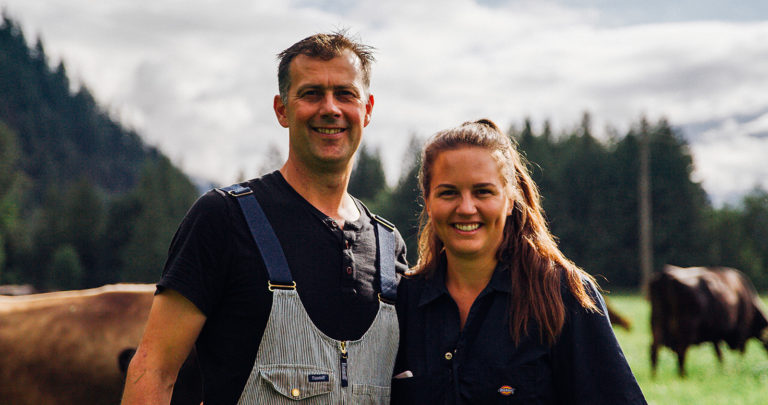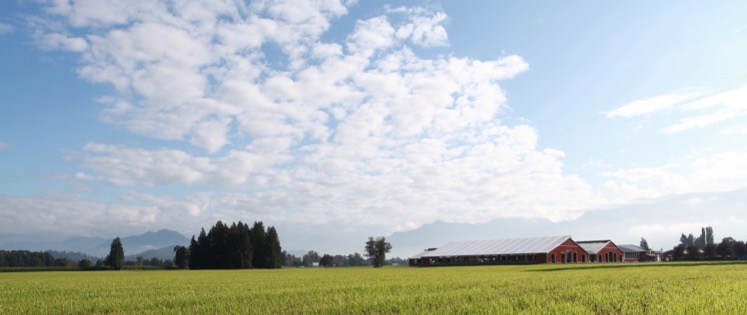On a bright and sunny day in September, the BC Dairy Association held a farm tour for 25 registered dietitians. This inquisitive group asked many questions! We’ve gathered the top ten for you in this post.
Dietitians came from many different areas including clinical, industry, private practice and community. As the tour bus headed towards the first destination in Agassiz, a buzz of excitement and chatter filled the air. The hour drive was a great opportunity for networking and for old friends to catch up.

The tour included four stops in the following order:
- UBC Dairy Education and Research Centre
- Lepp Farm Market for a BBQ style lunch
- A split organic and conventional dairy farm
- Golden Ears Cheesecrafters
Below is a Q & A of the top questions asked during the dairy farm tours:
- What is the average herd size of a dairy farm?
The average number of milking cows on a dairy farm in BC is 130.
- What are the benefits of supply management?
In short, because Canadian production is matched to Canadian demand, producers can expect a stable and fair income, processors get a stable and predictable supply of product, and consumers are provided with a consistent choice of excellent and high quality products at reasonable prices.
More details on specific benefits at the producer, consumer, community, and federal level can be found in this article: What’s in store for the future of Canada’s supply management system? - Should calves be housed together?
On most dairy farms, calves are housed individually for 2-3 months until weaned. They are then put into groups. This is done to prevent the spread of disease. The UBC Dairy Education and Research Centre is currently investigating whether or not there is a better alternative to this practice. Stay tuned for the results! - How often do cows have pasture access?
This varies by farm and whether or not the farm is producing organic milk. On a conventional dairy farm, there is no requirement for the cows to have pasture access, but many farms do allow outdoor access for their cows when possible.
On an organic dairy farm, access to pasture (a minimum of 1/3 acre per cow) is required during the grazing season and access to the outdoors is required at other times, weather permitting. This allows for flexibility with poor weather, especially during the winter months when the cows would rather be in a warm, dry barn! - Many barns are equipped with large rotating brushes, which help increase a cow’s comfort and happiness—it is like a “cow massage!” How important are these brushes to cows?
The researchers at UBC were also wondering about the answer to this question. So, they did a study to see how much effort (to move a weighted gate) the cows were willing to put in to get access to a brush. They determined that the brush is almost as important as food to the cows! They sure like their massages. - Why do conventionally raised cows produce more milk than organic cows?
This is likely due to the feed as organic cows eat less grain (which is energy dense) and more grass and hay. - How long after giving birth to a calf is a cow milked?
Typically, a cow will be milked within 12 hours after giving birth. However, for the first three days after giving birth, the milk, called colostrum, can only be given to calves. After three days, the milk returns to the usual collection system. - What is the average lactation period?
The average lactation period is about 10 months—cows then get a 2-month or so break from milking. This break is called a dry period. Read more about the process of producing milk From Farm to Family. - What is the average length of time a cow spends on a dairy farm and what happens to a dairy cow when it isn’t needed on the farm any longer?
The time a cow spends on a dairy farm can vary from 5-12 years. Smaller animals usually last longer. Retired dairy cows typically go into the beef industry and are used for hamburger meat. - Why is corn fermented into silage for food for the cows?
Much of the starch in field corn is not digestible. The fermentation process breaks down the starch so it is easier for cows to digest.
Thank you so much to all the dietitians that attended this fun and educational event! Due to popular demand, we plan to hold another farm tour in the spring. Stay tuned for details! Hungry for more information? Read more about life on a dairy farm and a day in the life of a dairy farmer.




